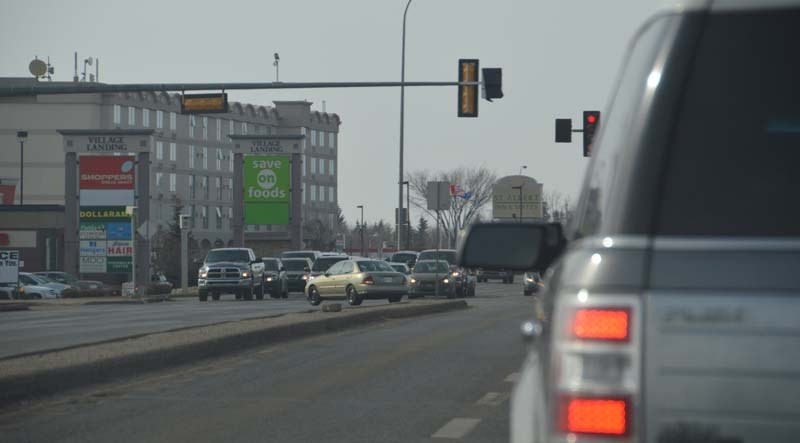Protected left-hand turns are doing what they were meant to do – improve safety on St. Albert Trail – even if they've brought about longer waits at intersections, says the city's top traffic engineer.
Protected left-hand turns are doing what they were meant to do – improve safety on St. Albert Trail – even if they've brought about longer waits at intersections, says the city's top traffic engineer.
Drivers may have noticed they are spending a longer time idling at intersections along the trail since the implementation of protected left-hand turns this spring, but preliminary data shows the collision numbers are down from last year.
“Safety and efficiency don't often get improved hand-in-hand,” said Dean Schick, the city's transportation manager.
Protected/prohibited left turns permit drivers to turn left only on a green arrow rather than on a solid green light.
The city began implementing protected left-hand turns in April with the goal of improving safety. Now 11 intersections along the trail from Gervais/Hebert to Coal Mine Road, and several side streets, have the protected turns.
New data shows that the number of total collisions on St. Albert Trail have dropped 41 per cent, from 114 collisions in 2013 (from January to the end of June) to 67 during the same time period in 2014. The number of left-turn collisions decreased from 24 in 2013 to seven this year. All seven collisions happened prior to the installation of the protected left turns.
“The results are positive on the safety side,” Schick said.
Some residents have questioned the necessity of the protected turns, he noted, because congestion along the trail seems worse than before. The reason behind that is traffic signals had to be re-timed.
When the protected turns were installed, the city also increased pedestrian walk times at controlled intersections, giving them more time to cross the road, Schick explained.
As a result, the cycle time for traffic signals – the amount of time it takes for traffic in all directions to get their turn at an intersection – has increased. Prior to the changes on the trail, average cycle time during peak traffic hours was 110 seconds. Now it is between 140 and 150 seconds.
“In order to provide five or 10 seconds to any movement (of traffic) we need to remove that same amount of time from another direction. If it's a left (turn), we have to take time away from the side streets or the opposing direction,” Schick explained.
Video cameras above traffic lights detect vehicles at an intersection, relaying information to an automated controller that adjusts traffic signals to cycle faster or slower depending on gaps in traffic.
Signal times are proportional to the amount of traffic, Schick said.
“It may come across to a driver as poorly co-ordinated, but you could have had good timing at one intersection but higher traffic volume at the next light.”
Traffic volumes have increased on both the trail and side streets over the last year, especially at the south end, Schick noted.
Now that the safety measures are in place, the transportation department is working to improve the co-ordination of signals to smooth out traffic flow. The timing changes are now in their final review stage but the city will still be completing drive-time studies to make sure the reforms are working, Schick said.
“You may be sitting at a location for an additional 10 to 20 seconds but the goal with improved co-ordination is that you make that time up going the speed limit down the corridor.”
